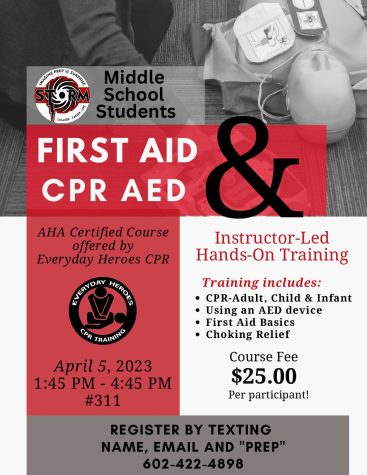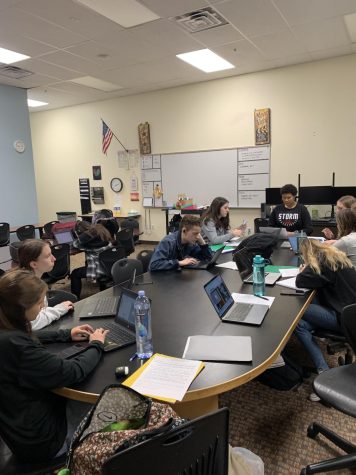How do students like to learn ?
There are many teaching styles and classroom structures. Each student has their preferences. To find the school average on student preferences, 39 students were polled. The poll was anonymous and sent to the whole school via a Schoology link. The poll asked students about their choice of classroom seating style such as flexible or traditional and desk placement. The second part of the poll asked students their favorite teaching styles, in general, and for each subject. The last part of the poll asked students about their preferences for office hours, such as time and method of help. This article will highlight the responses to the survey.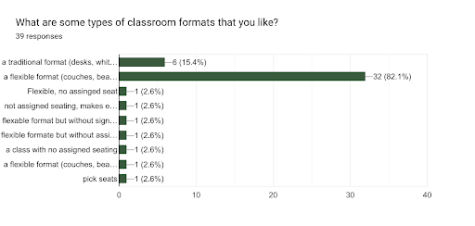
Out of the 39 students who answered the survey, a majority selected flexible seating. Flexible seating consists of a flexible format with couches, bean bag chairs, desks, tall tables, yoga balls, and seating on the floor. A whopping 82% voted that they like this format. In the poll, for each question there is an “other” option, this allows students to input their preferences that were not listed in the survey. Students are also allowed to choose multiple options. Out of the 82% who voted for flexible seating, 18% of students voted to have no assigned seating along with flexible seating.
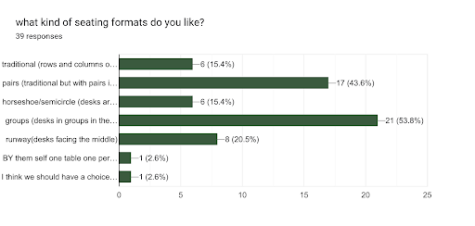 Students got to choose multiple preferred desk options such as traditional (rows and columns of single desks), pairs (traditional but with pairs instead of single), horseshoe/semicircle (desks around in a horseshoe around the central board), groups (desks in groups in the classroom), and runway (desks facing the middle). Out of the responses, 44% liked pairs, 54% selected groups, and 21% liked a runway. Sitting in groups is favored by most students. Traditional and horseshoe were the least popular.
Students got to choose multiple preferred desk options such as traditional (rows and columns of single desks), pairs (traditional but with pairs instead of single), horseshoe/semicircle (desks around in a horseshoe around the central board), groups (desks in groups in the classroom), and runway (desks facing the middle). Out of the responses, 44% liked pairs, 54% selected groups, and 21% liked a runway. Sitting in groups is favored by most students. Traditional and horseshoe were the least popular.
The second part of the survey asked students about their favorite teaching styles. The options for the students to choose from are; lecture, discussion, hands-on, seminar, case study, and others.
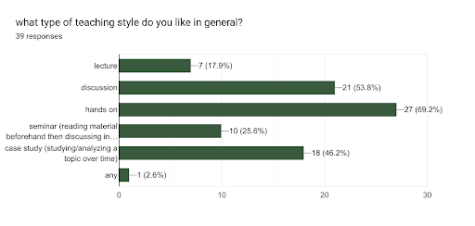 For general studies, students liked to learn from a hands-on perspective, around 69%. Next was discussion-based learning, about 54% voted for this. Third was a case study where 46% of students prefer to analyze a topic over time.
For general studies, students liked to learn from a hands-on perspective, around 69%. Next was discussion-based learning, about 54% voted for this. Third was a case study where 46% of students prefer to analyze a topic over time.
For subject-specific learning styles, these results were different.
For English, discussion-based learning was up top with discussion-based learning, with 54% of responders voting for it. Hands-on learning is next, with 28% of responders. Seminar gets 23% of responders voting for it. Students favored discussion-based learning for English. 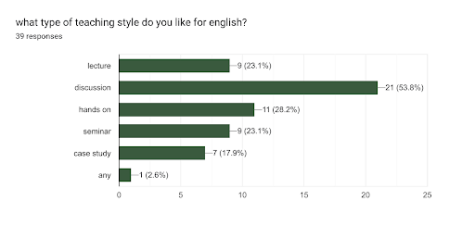
Math was similar to general studies, with the majority (54%) voting for hands-on learning. Discussion-based learning was next with 41% of voters. A case study was next, with 23% of voters. For a harder subject, it would make sense that hands-on learning would come up top. 
For social studies, discussion-based learning was the most helpful for students, getting around 46% of voters. Hands-on learning was next with 41% of voters. Then was the lecture, with 33% of voters, in contrast to general studies’ 18% of voters. Case study-based learning was in 4th place, to the author’s surprise. They thought it would be more popular. 
Science is the last part of this category and is the only one with an extra option, Lab. Out of the 6 options, 69% voted for hands-on learning. Next came Labs with 67% of votes. The rest only got a few votes, discussion (28%), lecture (18%), case study (13%), and seminar (10%). This landslide of votes is not surprising, many like to use labs as a way to learn. Hands-on learning is similar to labs which would explain why it has a majority of votes. 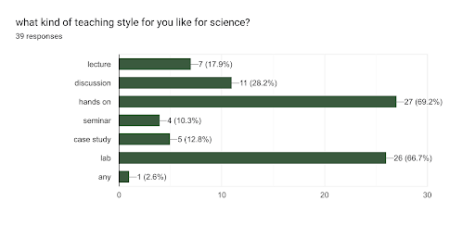
The last portion of the survey asked students about their preferences for office hours. There were only two questions for this section.
Students were asked when they prefer office hours. The options were before and after school, on Wednesdays, and during the individual time of class. The majority of students selected after-school office hours, and out of 39 voters, 69% voted for it. Many students (36%) selected to ask for help during the individual time of class. Before school office hours were the least popular. 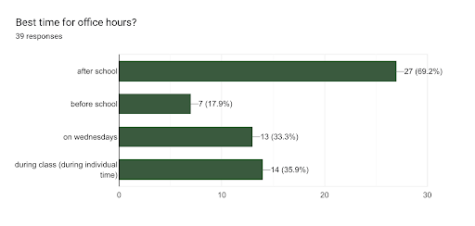
When asked what kind of help is most helpful for office hours, the most liked one-on-one help (51%). Students then favored small group help (31%), where a small group of students relearned with a teacher. They were students who favored being self-paced through the lesson by themselves with 28%. A small percentage, 26%, voted to have a reteach, similar to what it taught in the classroom. 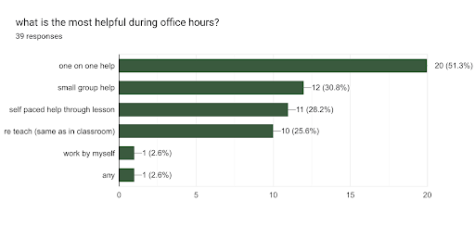
Students have many learning preferences. This information can be helpful for teachers when addressing the best ways to teach their students. In general, students preferred flexible seating with desks in groups. For learning, many liked hands-on learning no matter the subject. Office hours were favored when they were after school with the student learning one-on-one with the teacher. I hope this information can help both teachers and students learn and teach better in the classroom.
